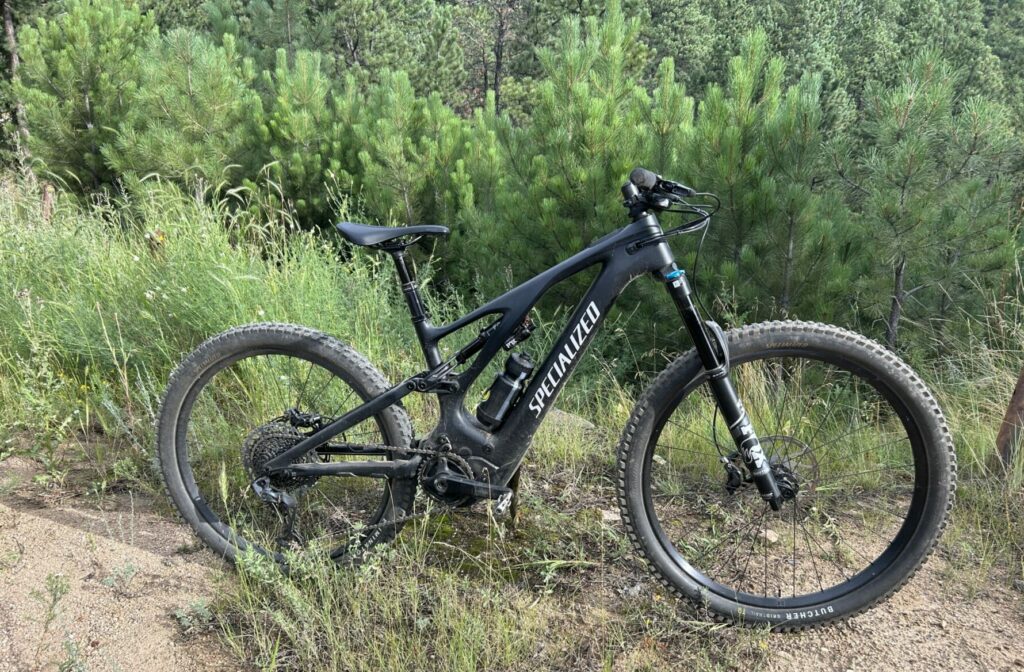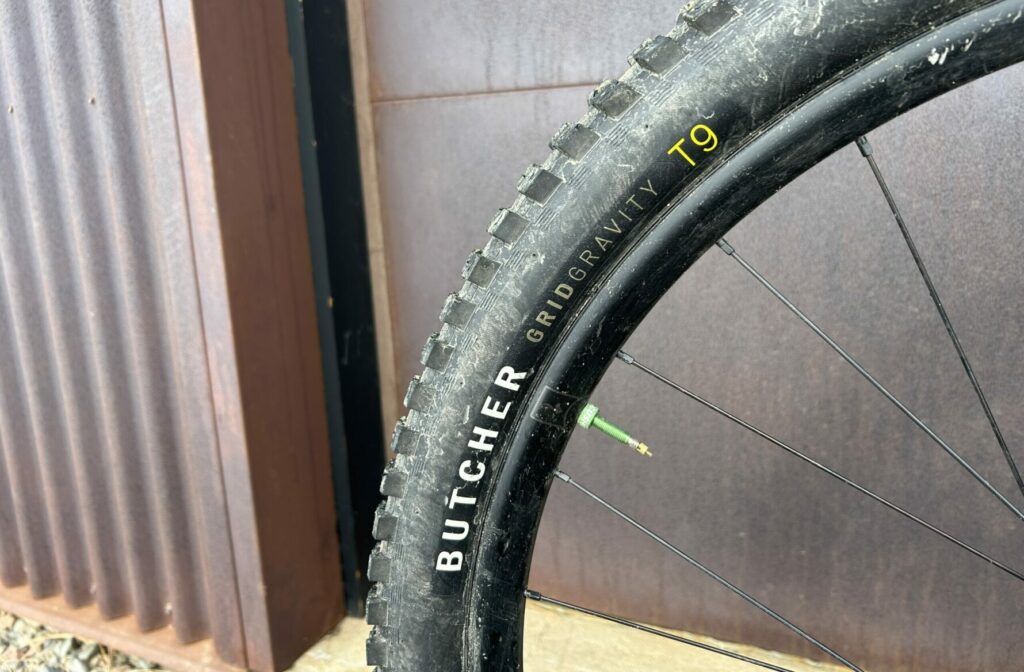If you lived through the ‘90s and early 2000s, you’ll remember that it took us a while to figure out mountain bike tires. Flats were endemic — even for Olympic contenders (just ask Ryder Hesjedal). Eventually, tubeless technology emerged, and though it was iffy at first, we figured it out. Thank goodness.
Today, It doesn’t take much research or critical thinking to set up a good set of tires on a conventional bike. Perhaps in a lot of circumstances, the same can be said for e-MTBs.
However e-bikes open up some intriguing possibilities that conventional bicycles don’t allow. Having extra power at your disposal makes gram-counting a bit pedantic. The bike’s additional weight makes durability a greater concern. And if you’re out on a long ride, rolling resistance might compromise battery life.
Over the last few months, I’ve experimented with a few tire configurations on my test bikes. This is far from an exhaustive review, but more like a jumping-off point for further fiddling once trails dry out in 2024.
The First Step: Mounting CushCore on my E-MTB
I covered this in a story earlier this fall, so no need to write the same thing twice. However, my opinion stands that either CushCore Pro or CushCore XC inserts are great upgrades for e-MTB tires. I was skeptical of running inserts front and rear, but now I wouldn’t have it any other way.
The weight penalty is pretty minimal and not detrimental on the trail. Dual inserts significantly quiet the bike’s ride. And if you’re worried about protecting your rims from impacts, this is the only surefire way to avoid costly damage.
Maybe someday I’ll try running DH tires sans-inserts, but not today. Or anytime soon, probably.
if you’re worried about protecting your rims from impacts, this is the only surefire way to avoid costly damage.
Going Big: How DH Tires Ride on an E-Bike
My Specialized Levo test bike came with Specialized tires with Grid Trail casing. For continuity and comparison, I opted for the Grid Gravity casing versions of the same tires. Okay, honestly, I also got a good price on those DH tires. Whatever my reasons, I think the Butcher and Eliminator tires work well on the rocky trails in my area.
Right away, it’s clear that the Gravity casing tires are much heavier and stiffer than the Trail casing options. They were considerably more difficult to install with CushCore inserts.
After a sweaty and exhausting garage session, they were mounted. And when they were mounted, the bike felt noticeably heavier, even when just picking up the front end to move it around the garage. On paper, these tires added about 600 grams to the bike, which is well over one pound.
Shuffling your bike around the garage isn’t the point, is it? Riding performance is what we really care about, so off I went to see how these new, heavier tires would handle. The difference was immediately apparent, better in some ways and worse in others.
The first thing I perceived, on nearly any terrain, was how the Gravity casing tires slowed down the Levo’s handling. This bike has always been a beefy full-power rig, but now it was a little slower to initiate turns, less inclined to pop off of jumps or subtle trail features, and reluctant to quickly change lines.
At any moment, these tires seemed to be on the brink of crushing the trail’s rocks into powder. Fantastic.
Now, that might all sound pretty negative, but it all depends on context. On flat or rolling trails, my bike’s new personality didn’t feel amazing, although it gave me a fantastic upper-body workout.
On steep, chunky trails (which I prefer), the already-capable Levo became an unstoppable six-wheeled amphibious military truck. Combined with the CushCore Pro inserts (not even as beefy as the e-bike inserts!), the Gravity casing tires were unflappable, holding whatever line I chose, refusing to deflect in even the worst sections. At any moment, these tires seemed to be on the brink of crushing the trail’s rocks into powder. Fantastic.
Along with the dual-ply casing, my downhill tires have softer rubber compounds, T9 (softest) in the front tire and dual-compound T7/T9 in the rear. This also plays a role in quieting the bike’s ride over choppy terrain.

Downhill Tires and E-Bike Battery Life
Now, those beefy, grippy downhill tires perform amazingly on pure trails (almost like they were designed for them, go figure), but there is a price to be paid.
On my first outing with these gravity tires, I got greedy. We rode one too many laps, just because it was a nice, early winter day, and with snow on the way, it was one of our last chances to get out on the trails for a while.
As I was riding home, I watched my dwindling battery go down, down, down. Eventually, it was dead. My midday ride quickly devolved into a threshold workout with a boat-anchor bike.
I may be an outlier, but I prefer to ride to the trails from my house. That’s one of the reasons I love e-MTBs. They cut out about an hour of round-trip driving, while still giving me a heavy-duty package to ride the gnar. But I do have to play a little game with my battery consumption to make sure I can get home without too much exertion.
My midday ride quickly devolved into a threshold workout with a boat-anchor bike.
This is all to say that, I misjudged how much more battery these new tires would consume. Between the extra weight and sticky rubber, downhill tires reduce an e-bike’s range. This can be compounded by riding style and ambient temperature. On both counts, I got it wrong that day, riding mostly in Turbo mode on climbs in relatively cold conditions. You don’t need to be a battery engineer to know that they don’t like extreme temperatures. (But I did talk to a PhD, if you want to read more.) Perhaps in mid-summer, this wouldn’t be as big of an issue.
Conclusion
From the get-go, I didn’t promise you an article that conclusively produced a verdict on downhill tires and e-MTBs. I am still undecided. Will my next pair of tires be dual-ply Gravity casing with sticky rubber? Or single-ply with sticky rubber? Or something else? I’m not sure.
While I’m head-over-heels for the stability I get from downhill tires on … uh, you know, downhills … I am a bit weirded-out by how they change my timing on technical sections. The extra weight requires a split-second of extra anticipation to unweight the bike or pop over rocks or change lines. I adapted my riding technique, but the tires exacerbates the bike’s existing tendency to feel like a big-old toboggan.
The battery consumption concerns are real too. Ever since I ran out of juice on that ride, I’m wary of how much I can ride before I need to head home.
On both counts — riding style and battery consumption — I’ve already gotten to the point where I feel more comfortable with these tires. I’m just not sure if it is worth the compromise, especially with how tire inserts improve the ride with single-ply tires.
I’d consider riding downhill tires without inserts, but then I’d worry about rim damage. I might also experiment with single-ply tires and softer rubber compounds, or vice-versa. Sounds like I need to wear out these tires soon so I can mount something else and continue tinkering.
P.S. We use affiliate links here at Direct Current. If you’re considering buying Specialized tires, we’ll get a little kickback if you purchase using a link from this story. 😀
